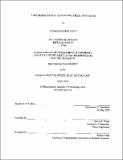| dc.contributor.advisor | Sylvia T. Ceyer. | en_US |
| dc.contributor.author | Holt, Judson Robert, 1974- | en_US |
| dc.contributor.other | Massachusetts Institute of Technology. Dept. of Chemistry. | en_US |
| dc.date.accessioned | 2005-08-24T19:57:24Z | |
| dc.date.available | 2005-08-24T19:57:24Z | |
| dc.date.copyright | 2002 | en_US |
| dc.date.issued | 2002 | en_US |
| dc.identifier.uri | http://hdl.handle.net/1721.1/8052 | |
| dc.description | Thesis (Ph. D.)--Massachusetts Institute of Technology, Dept. of Chemistry, 2002. | en_US |
| dc.description | Also issued in leaves. Vita. | en_US |
| dc.description | Includes bibliographical references. | en_US |
| dc.description.abstract | The interaction of low energy XeF2 with Si(100)2x1 has been investigated by studying both the surface-bound and gas-phase products of the reaction. Helium atom diffraction, beam-surface scattering and thermal desorption measurements are the major techniques used to probe the surface-bound products of the reaction. It is found that XeF2 dissociatively chemisorbs with high probability solely on the Si dangling bonds up to a coverage of about one monolayer (ML). Molecular fluorine has previously been observed to react similarly, saturating the dangling bonds at 1 ML coverage. The thermal desorption products and kinetics from the fluorinated layer produced by XeF2 exposure are identical to that produced by F2 exposure. The interactions of XeF2 and F2 are also strikingly similar with respect to the order of the Si surface up to about 1 ML coverage. The surface order is monitored by He diffraction detected by a line-of-sight, differentially pumped mass spectrometer. In both systems, the diffracted He beams exhibit a sharp decrease in intensity due to the disorder produced by the fluorination of random surface unit cells as the coverage increases from zero to about 0.3 ML. The intensity then increases until the fluorine overlayer has fully recovered its 2x 1 periodicity at about 1 ML. This recovery corresponds to the decoration of each Si dangling bond with a fluorine atom. A critical observation of this study is that despite the large exothermicity of the dissociative chemisorption of XeF2 or F2, which is approximately 230-250 kcal/mol, the order of the surface is not destroyed in either system. After saturation of the dangling bonds, F2 ceases to react with the surface while XeF2 continues to deposit fluorine by reacting with the Si-Si a dimer bonds and the Si-Si lattice bonds. | en_US |
| dc.description.abstract | (cont.) The order is destroyed as a result of the continued fluorine deposition and ultimately etching occurs by the formation of volatile SiF4. The gas-phase products of the reaction are studied using the time-of-flight (TOF) technique. The translational excitation of XeF from single atom abstraction is observed to be only a small fraction of the reaction exothermicity, implying that the abstraction reaction can be described by a potential energy surface with a transition state in the entrance channel. Furthermore, the angular distribution of the XeF becomes peaked towards normal on a fluorinated surface, suggesting that the combined influence of molecular steering and steric hinderance serve to align the XeF2 into a more favorable perpendicular orientation prior to the reaction. The observation of reactively scattered F atoms indicates that some of the XeF from atom abstraction dissociates to produce a F atom and a Xe atom. This dissociation is modeled using the conservation of energy and momentum to predict the trajectory of the scattered F and Xe atoms from the gas-phase dissociation of XeF in a forward convolution calculation that takes into account the initial velocity, scattering angle, orientation and energy distributions of the XeF prior to dissociation. The calculation successfully predicts the observed F and Xe atom TOF distributions at all angles and coverages. ... | en_US |
| dc.description.statementofresponsibility | by Judson Robert Holt. | en_US |
| dc.format.extent | 281 p. | en_US |
| dc.format.extent | 16697922 bytes | |
| dc.format.extent | 16697674 bytes | |
| dc.format.mimetype | application/pdf | |
| dc.format.mimetype | application/pdf | |
| dc.language.iso | eng | en_US |
| dc.publisher | Massachusetts Institute of Technology | en_US |
| dc.rights | M.I.T. theses are protected by copyright. They may be viewed from this source for any purpose, but reproduction or distribution in any format is prohibited without written permission. See provided URL for inquiries about permission. | en_US |
| dc.rights.uri | http://dspace.mit.edu/handle/1721.1/7582 | |
| dc.subject | Chemistry. | en_US |
| dc.title | The interaction of xenon difluoride with Si(100) | en_US |
| dc.type | Thesis | en_US |
| dc.description.degree | Ph.D. | en_US |
| dc.contributor.department | Massachusetts Institute of Technology. Department of Chemistry | |
| dc.identifier.oclc | 51012798 | en_US |
